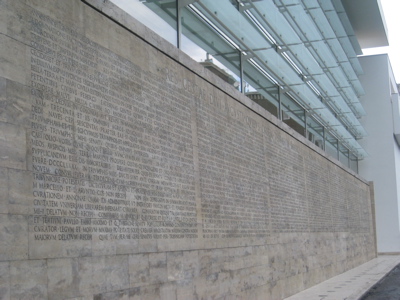Roman emperors were buried in Hadrian's tomb for the next century up through Caracalla in 217 CE. In the 5th century it was converted into a military fortress. In the 14th century, the pope's of the nearby Vatican (a mere half kilometer away) built a passageway directly to the structure in which to take refuge when Rome was under siege. Throughout all the changes in function, the upper additions were added on as well as the defense wall. During the time when central Italy was officially called the Papal States, the building was used as a prison. In 1901 it was decommissioned and today it is a tourist site, museum and the location of perhaps the most stunning view of Rome.
Monday, February 01, 2010
Castel Sant'Angelo aka Hadrian's Mausoleum
Roman emperors were buried in Hadrian's tomb for the next century up through Caracalla in 217 CE. In the 5th century it was converted into a military fortress. In the 14th century, the pope's of the nearby Vatican (a mere half kilometer away) built a passageway directly to the structure in which to take refuge when Rome was under siege. Throughout all the changes in function, the upper additions were added on as well as the defense wall. During the time when central Italy was officially called the Papal States, the building was used as a prison. In 1901 it was decommissioned and today it is a tourist site, museum and the location of perhaps the most stunning view of Rome.
Sunday, January 31, 2010
Ara Pacis Augustae
In 44 BCE, Julius Caesar was murdered and for thirteen years the Roman world was subject to civil war. In 31 BCE, Octavian, Caesar's grandnephew and adopted son emerged victorious and from 27 BCE to 14 CE, he was the ruler of Rome. Octavian is better known to all of us as Augustus. Augustus was not only a great military general but an outstanding administrator. He set up institutions and built public infrastructure that had lasting positive influence for the next few centuries. He did such a good job and left such a legacy that even his bumbling descendants of the next century couldn't undo the good that he did. The Roman Senate conferred upon Augustus the title of "princeps" the first of all citizens and he occupied all key positions. His rule was the time in the Roman world known as PAX AUGUSTA, the era of Roman peace.
Here he is, Augustus. I have to say, I kind of have a crush on him.
In 13 BCE the Ara Pacis Augustae (Altar of Augustan Peace) was started. The monument celebrates important moments in his life and as a symbol of the prosperity Augustus brought due to the fact that the Roman world was in a time of peace.
The original location of the Ara Pacis was on the open campus/plain north of the Pantheon. It was built on next to a sundial. Along the Tiber in the far distance, Augustus built his tomb. The original location of the Ara Pacis was in the Tiber's flood plain and over the course of centuries was buried by mud. In 1938, it was decreed that the Ara Pacis' pieces were to be brought together and reconstructed. The modern site is along the river to the left of Augustus' tomb.
In 2006, a modern building was built to house the Ara Pacis. It was built by Richard Meier and is not popular. Here is the water in front which is brilliant in the fact that it prevents the wall from being tagged.
On the side of the Meier building that faces Augustus' tomb is his "Res Gestae" or the instructions he left to his descendants on his philosophy and ideas for maintaining and building the Roman world.
Here is the Julio Claudian family tree. Augustus' third wife Livia is rumored to have made sure that all of Augustus' children and grandchildren by his previous marriage were dead by the time Augustus passed away. Thereby when it was time to determine a successor, her son by a previous marriage, was named the leader of Rome.
On a separate note, notice here how Marcus Agrippa, son-in-law of Augustus by a early marriage, died in 12 BCE.
Marcus Agrippa's son Agrippa Postumus was born in 12 BCE after the of this father. Not sure if the concept of "posthumous" was named for this event or if the boy was named after the concept.
Inside the Ara Pacis is the altar at which sacrifices were made.
The most famous panel shows a woman with two babies and a bounty of fruit. This is most likely a depiction of the great benefits that Augustan peace has brought to the people of the Roman world.
Along the sides of the Ara Pacis are these long processions which are thought to be a glimpse of the inaugural procession in 13 BCE.
Here is the procession on the South side from back to front. It's charming in the fact that children are included acting like children, not like little adults. They are tugging at their parents clothes and talking to each other when they should be behaving themselves. Augustus probably had children included as a sign that having children was noble due to his worry of a declining birthrate.
The hooded figure on the left is most likely Marcus Agrippa.
Here we are getting closer to the front of the royal family but I neglected to actually photograph Augustus himself.
Subscribe to:
Comments (Atom)






















